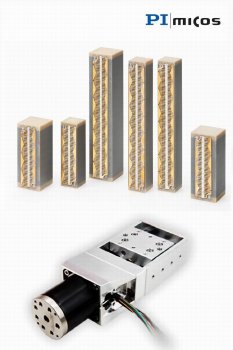Long before Curiosity started its long journey to Mars, when NASA decided to have positioning stages from miCos GmbH and piezoelectric actuators from PI (Physik Instrumente) LP work together millions of miles away on the Red Planet, both companies were not aware that a down-to-earth collaboration lay in their near future.

Endless tests (in the case of the piezo actuators 100 Billion cycles) and qualifications had to be passed, before the precision positioning equipment was sent off into space. Failure was not an option, but cost definitely was an issue and budgets are tighter now than in the early days of space exploration. Manufacturers with the best commercial off the shelf products (COTS), proven quality systems and the ability to make the necessary modifications for the tough space requirements are high on the list when it comes to providing the ingredients for a 21st century space mission.
CheMin Instrument: Piezo Stacks for Sample Feed
PI Physik Instrumente's contribution to the Mars mission, the PI Ceramic monolithic piezo actuators (PICMA) were put to use in the Chemistry and Mineralogy instrument (CheMin) described at http://msl-scicorner.jpl.nasa.gov/Instruments/CheMin .
CheMin is an X-ray diffraction-capable mineralogy instrument whose purpose is to determine if water was present in the formation of Martian rocks and soil.
A sample handling system is required to feed mineral powder samples through a funnel into the individual sample cells. The powder in the tunable sample cells must be shaken at variable amplitudes and frequencies in the range of 0.9 to 2.2 kHz to homogenize particle size or density segregations. The precisely controlled vibrations are generated by PICMA multilayer piezo actuators from PI Ceramic. These ceramic-encapsulated actuators emerged after rigorous tests by NASA's JPL as the highest reliability piezo stacks commercially available. Multiple samples passed 100,000,000,000 cycles of life testing with no failures, maintaining greater than 96% of their performance at the end of the test.
ChemCam and the MT-40 Autofocus Positioning Stage by PI miCos
The instrument equipped with the PI miCos precision motorized positioning stage is called ChemCam (Chemistry and Camera instrument), consisting of a laser induced breakdown spectrometer and a high resolution imaging camera.
ChemCam determines through laser-based remote pretesting which rocks in the vicinity of the rover (distances up to 9 m) warrant a closer examination with in-situ instruments.
The high-power laser beam evaporates the rock and the light emitted from the plasma is analyzed with the spectrometer (see http://www.msl-chemcam.com/index.php?menu=inc&page_consult=textes&rubrique=64&sousrubrique=224&soussousrubrique=0&art=259 for further information)
A specially modified and space qualified MT-40 linear positioning stage from PI miCos focuses the analyzing system at the desired distance by translating the secondary mirror of the telescope. Due to violent shocks and vibration during launch and landing, every component in the stage from the stepper motor to the crossed roller bearings and limit switches had to be closely examined and optimized to eliminate the possibility of failure or performance loss. For fast and precise focusing, high resolution and linearity are required and backlash has to be controlled tightly -- not an easy task given the very wide operating temperature range of the instrument. Modeling and thermal compensation were used as well as special vacuum compatible lubricants for all moving parts. In the end the modified stage passed all the tests and the decision to go with a COTS part for cost control reasons proved right.
Shortly before Curiosity left Earth in November 2011, miCos joined the PI family of companies. Together they are now ready to take on any precision positioning challenge, in air, under high vacuum conditions on Earth and in locations as remote as Mars.